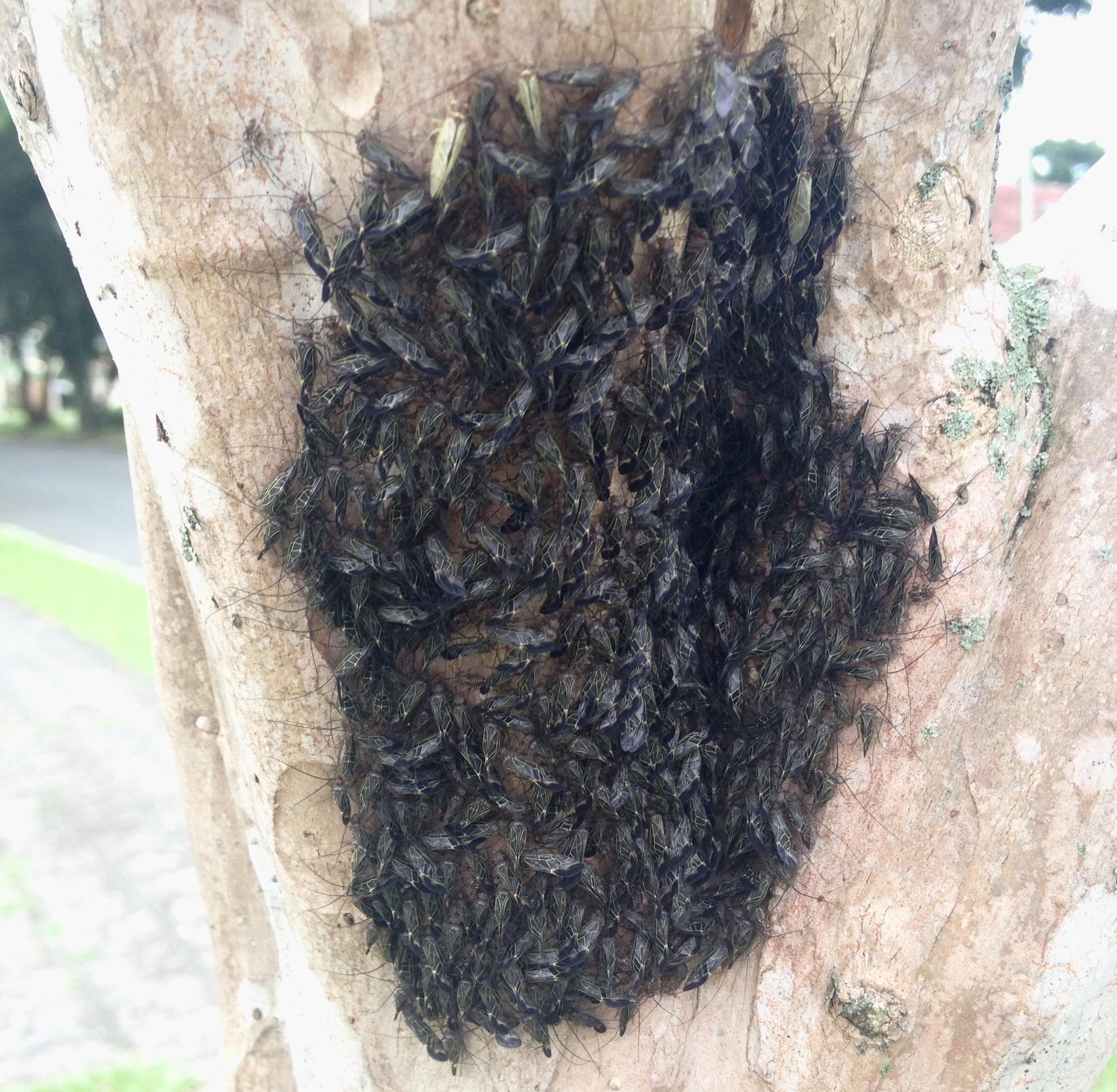Taking a walk around your yard, you notice a section of a tree trunk or some branches covered in tiny bugs clustered together. This sight might alarm you, but try not to panic. Many bugs found in groups on trees are harmless, while some may indicate a pest problem needing action. Learning to identify the common culprits helps you know when control is needed.
Harmless Tree Bugs
Several bugs that congregate on trees don’t damage them and can be left alone:
Barklice
Also called booklice or psocids, these tiny, soft-bodied insects feed on lichens, fungi, and algae on tree bark. Large groups may form, appearing like moving dark dust. Barklice don’t directly hurt trees, though large populations indicate high moisture ideal for fungal growth. Prune branches for better air circulation and reduce watering.
Aphid Lions
The larvae of green and brown lacewings, called aphid lions, gather in groups to feed on tree-damaging aphids and other small insects. Beneficial aphid lions help control pests, so avoid pesticides if you find them on a tree. Their prey-eating habit earns them their “lion” nickname!
Ladybug Larvae
Like lacewings, ladybug larvae and adults are valued predators that help reduce plant pests like aphids, scale, and mites. Seeing a cluster of ladybug larvae on a tree likely means they are feasting on a pest infestation. Let them continue their great work!
Scale Insects
While scale insects can damage trees, clusters of them along with ladybugs or parasites indicate biological control is underway The scales may already be dead or dying, so avoid spraying pesticides
Harmful Tree Pest Clusters
Watch for these grouped insects that can seriously impact tree health
Tent Caterpillars
Tent caterpillars weave large, visible silken tents in tree branches and feed in hordes on foliage. Severe infestations defoliate trees, making them weak. Look for tents in early spring and prune or pull them out. Spray nearby foliage with Bacillus thuringiensis (Bt) to kill young caterpillars.
Gypsy Moth Caterpillars
These caterpillars swarm trees and rapidly consume leaves. They move en masse like a creepy black wave! Bt spray or disruptive pheromones deployed before caterpillars hatch provide control. Or wrap a sticky barrier around susceptible trees to trap the leaf-eaters.
Pine Bark Beetles
Many beetle species mass attack pines, chewing under the bark and cutting off nutrient flow. This leads to tree death. Keep trees vigorous with proper care and prune out infested branches. Preventive trunk sprays may deter some beetles. Severely damaged trees should be removed before beetles spread.
Spotted Lanternflies
Originally from Asia, these invasive pests cluster on trunks to feed on sap, excreting sticky “honeydew.” The honeydew and damage stresses trees and promotes mold. Check for egg masses on trees in winter. Remove them to reduce numbers. Sticky bands around trunks trap nymphs and adults.
Bagworms
Bagworm larvae gather on conifers and other trees enclosed in spindle-shaped bags made of foliage. They eat tons of leaves and can fully defoliate trees. Manually remove bags in winter to reduce next year’s population. Apply Bt in late spring targeting young larvae before they make bags.
Eriophyid Mites
Microscopic eriophyid mites group on leaves or buds, distorting growth and causing galls or witches’ brooms (dense masses of shoots). Severe infestations weaken trees. Spray horticultural oil or insecticidal soap in early spring before damage begins to control overwintered mites.
Bark Beetles
Many beetle varieties tunnel beneath bark, destroying the inner nutritious phloem and cambium tissues. Trees become weakened and may die. Keep trees healthy and reduce stress, their main susceptibility factor. Preventive trunk sprays can help. Harvest or remove beetle-infested trees immediately.
Take Action for Tree Health
When you spot a large grouping of insects on your trees, identify if they are harmless or harmful. Protect valued trees from damaging pests by taking these proactive steps:
-
Maintain tree vigor through proper watering, fertilization, pruning, and mulching. Healthy trees resist pests better.
-
Check for pests like egg masses in winter and treat early before populations explode.
-
Use preventive sprays like horticultural oils and Bt at the right time of year.
-
Monitor for early signs of infestation like leaf damage or limb dieback.
-
Remove severely infested branches or whole trees to prevent spread.
-
Foster natural predators like birds and beneficial insects. Avoid broad-spectrum pesticide use.
With vigilance and timely action, your trees can thrive despite occasional pest outbreaks. Taking a walk through your landscape is a great way to tune in to what’s happening. Getting familiar with common tree-dwelling bugs will give you confidence to support tree health.
WHAT IS EATING MY PLANTS? | Common Garden Pest Control using Leaf Signatures
FAQ
How do you get rid of scale bugs on trees?
How do you get rid of a bug infestation in a tree?
What do tree lice look like?
How do you get rid of tree eating beetles?
- A Complete Guide to Caring for Yuki Cherry Blossom Shrub - January 23, 2025
- Identifying Red Hot Poker Seeds: What to Look For When Harvesting Torch Lily Pods - January 23, 2025
- A Complete Guide to Harvesting Evening Primrose Seeds - January 23, 2025

